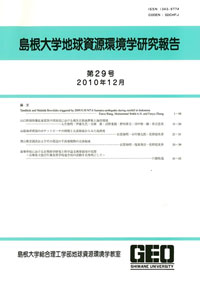島根大学総合理工学部地球資源環境学教室
ISSN:1343-9774

ダウンロード数 : ? 件
この文献の参照には次のURLをご利用ください : https://ir.lib.shimane-u.ac.jp/31604
島根大学地球資源環境学研究報告 33
2015-02-27 発行
潮汐変動と浮遊物質量の関係およびアマモの地球化学的検討からみた瀬戸内海笠岡湾干潟の環境評価
Examination of tidal flat environment from geochemical analysis of suspended solid in relation to tidal change and of Zostera marina in Kasaoka Bay, Seto Inland Sea, Southwest Japan
佐野 絵里香
ファイル
内容記述(抄録等)
Examination of tidal flat environment of the Kasaoka Bay in Seto Inland Sea was carried out from geochemical analysis of suspended solid (SS) in relation to tidal variation. Geochemical compositions of Zostera marina (submerged plan) was also examined for evaluation of water environment. Material filtered on quartz filter was observed using SEM and further analyzed by XRF to evaluated geochemical compositions. This method is a new examination for the SS in view point of both constituent observation and geochemical compositions. SS value varies with tidal change, namely, it increases toward the ebb tide. This is suggestive of increasing of detritus of tidal flat environment. SEM observation demonstrates that the material of the spring tide was composed of diatom mainly of Skeletonema sp. and some Chaetoceros sp. and Asterionella sp. were observed. The SS of ebb tide was fine grained detritus including fragment of biogenic material. Geochemical compositions of the SS of spring is characterized by higher contents of P_2O_5, while that of ebb tide is enriched in heavy metals such as Zn, Cu, Cr, Fe and Mn. Although Br, F and Cl were measured for SS, iodine was not detected for all SS samples. This is suggestive of lacking of intake of iodine for diatom of these samples. Geochemical composition of Z. marina showed higher concentration of Zn, Cu, TS (total sulfur), iodine, MnO and P_2O_5. Comparative examination of Z. marina from other localities of Seto Inland Sea shows that the Kasaoka Bay samples show higher values in Zn, Cr, MnO and P_2O_5, suggesting enriched water environment of antholopologenic inputs. The Kasaoka Bay samples, however, show similar values to those of the Ise-Matsusaka area of Pacific Sea, excluding Zn concentration. I- P_2O_5 diagram is useful for evaluation of nutrient competition between Z. marina and marine plankton and eutrophication of marine condition.
Other Article
PP. 19 - 27
